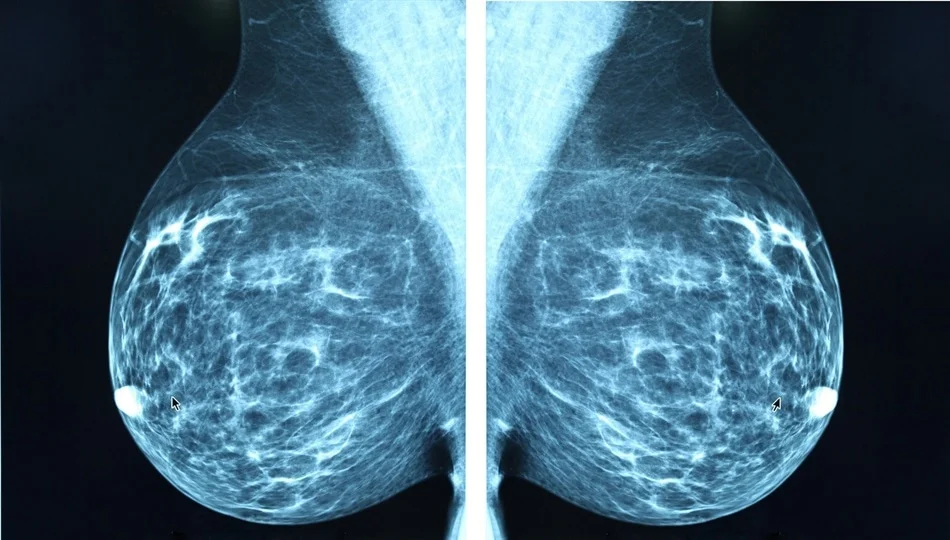Health
Breast Cancer Detection Is Better With MRIs Or CEMs?

When it comes to diagnosing breast cancer, which modality—contrast-enhanced mammography or dynamic contrast-enhanced breast magnetic resonance imaging—is more effective?
Radiologic Clinics published an article in July stating that it is dependent on a variety of factors, and the paper was quite informative.
Even though CEM performs marginally worse than MRI when it comes to breast cancer diagnostic imaging, colleagues Dr. Valentina Longo of Fondazione Policlinico Universitario in Rome and Dr. Ritse Mann, PhD, of Radboud University Medical Center in Nijmegen, the Netherlands, pointed out that in “many situations [it is] a viable alternative.”
Mammography is the most common way to screen for breast cancer.
Despite its limitations, the most notable of which is a diminished capacity to detect disease in thick breast tissue, mammography is the method that is being used.
Mammography has a number of limitations; however, ultrasonography is an alternative screening tool that can circumvent some of those limitations.
Nevertheless, the group made the observation that contrast-enhanced imaging, which provides functional information about the vascularity of the tumour, “strongly boosts the cancer detection rate in screening and also improves staging,” indicating that this imaging modality has the potential to be useful in the diagnosis of breast cancer.
Although contrast-enhanced mammography (CEM) was not available until 2011, dynamic contrast-enhanced breast MRI has been available since 1984.
CEM has been approved by the Food and Drug Administration (FDA) of the United States of America as an auxiliary modality for follow-up diagnostic testing for breast cancer; however, it has not been approved for screening purposes.
“CEM is mainly suggested as an alternative to MR imaging when MR imaging is not feasible for a patient,” according to the researchers Mann and Longo.
In addition to providing guidance on which of these contrast-enhanced treatments should be utilized in a certain clinical setting, the researchers also discussed some of the many benefits and drawbacks associated with each procedure:
Upon diagnosis of breast cancer,
Contrast-enhanced mammography (CEM) has been shown to have enhanced sensitivity (90.5% versus 52.4%) and decreased specificity (76.1% versus 90.5%) in comparison to regular mammography.
Based on earlier studies, the specificity of breast magnetic resonance imaging (MRI) can reach up to 98%, while its sensitivity can reach up to 100%. Nevertheless, this would suggest that the variable settings that were utilized in the process of calculating these statistics had to be taken into consideration.
Particularly well-visible on magnetic resonance imaging (MRI) are regions such as the axilla and far posterior locations, which are sometimes difficult to identify on mammography. The price, on the other hand, is significantly higher, and insurance might not always cover it.
According to the study participants, breast MRI is specifically recommended for very high-risk patients, such as carriers of the BRCA gene mutation, since they begin screening early in life and are more susceptible to radiation damage.
It will take contrast-enhanced microscopy (CEM) significantly longer to obtain images of the prepectoral and axillary breast regions than it does with breast magnetic resonance imaging (MRI).
Magnetic resonance imaging (MRI) of the breast is an extremely useful imaging technique for individuals who have had implants placed, since it allows an examination of the integrity of the implants.
Chemotherapy response evaluation using breast magnetic resonance imaging (MRI) is considered to be a regular practice.
Breast Cancer MRIs do not administer radiation.
What’s the last word? It is necessary to give some consideration to the selection of an imaging modality for the diagnosis of breast cancer.
“Factors to take into account when choosing between modalities include the likelihood of strong background parenchymal enhancement (that can be better managed with MR imaging), the importance of radiation (particularly relevant in young women), the availability of equipment, and women’s preferences (due to claustrophobia, compression, noise, and so forth),” according to the researchers Mann and Longo.
SEE ALSO:
What Is Alevemente? Exploring Its Use, Guide, and The Benefits
Health
NYC Legionnaires’ Outbreak Reaches 90 Cases; 3 Deaths Are Reported

(VOR News) – According to the New York City Department of Health, 90 people have been ill and three have died from Legionnaires’ disease in Central Harlem. The authorities made the declaration.
In recent days, the city’s health office has suggested stricter guidelines for assessing building-based cooling towers. The towers in question are suspected of being the origin of the outbreak.
Just before Legionnaires became effective, the proposal was made.
Buildings can be cooled thanks to cooling towers, which are enormous devices that are placed on rooftops and release mist into the surrounding air. Mist is dispersed around the area by these towers. Using cooling towers is standard procedure in the building industry.
Legionella bacteria can grow in the tower if the water is not well cleaned or if it is excessively hot. By breathing in this filthy mist, people expose themselves to the risk of getting sick. This exposes them to the risk of being ill.
According to a Department of Health spokeswoman who talked to CNN, the new law “was in development well before the Legionnaires’ cluster in Central Harlem.” This information was obtained by CNN. CNN was successful in obtaining this information.
Building owners must register and maintain their cooling towers, which are inspected on a regular basis, according to CNN. Inspections of cooling towers are also possible. Cooling towers can also be inspected on their own initiative. Building owners are required by the current state law to provide this information to the authorities in charge of gathering it.
The proposal under consideration stipulates strict testing schedules, state-certified laboratories to analyze samples, and penalties for noncompliance.
As of right now, there is no information available on the financial penalty. Currently, there are fines ranging from $500 to $2,000 each instance for noncompliance with the maintenance requirements. These penalties may be applied to each case separately.
However, it is probable that significant issues may arise during the enforcement process. Inspections have significantly decreased, with fewer than half as many in 2024 as in 2017, when the city started keeping track of them, according to Gothamist, a non-profit journal affiliated with WNYC public radio.
Gothamist supplied this information. There is a significant discrepancy between these figures and the 2017 inspections. The city developed these specifics based on the data it had collected.
July 25th saw the city announce the Legionnaires cluster
Following an assessment of all operational cooling towers in the area, health department officials cleaned any cooling towers in the impacted area that contained Legionella. The authorities were the ones that supplied this information.
In the United States of America, the Centers for Disease Control and Prevention (CDC) has determined that pneumonia is actually a subtype of legionnaires’ disease. The CDC created this classification system.
You may experience a number of symptoms, such as coughing, fever, headaches, muscle problems, and shortness of breath, among others. You run the danger of experiencing a number of symptoms. Additionally, shortness of breath is another symptom that may be present.
The suggested plan of action for treating the illness is to utilize antibiotics. If you decide to ignore it, you could end up with serious issues like lung failure or even death. These issues might be avoided with the help of the treatment.
The data presented by the Occupational Safety and Health Administration (OSHA) suggests that there are roughly 6,000 reported incidents that occur in the United States of America each year.
According to those working in the medical field, the true figure is much greater than what is typically believed to be true. One of the factors contributing to this misperception is the difficulty in distinguishing between various forms of pneumonia, such as Legionnaires’ disease and other forms of pneumonia.
SOURCE: ME
SEE ALSO:
Preliminary Studies Show Eli Lilly’s Weight Loss Medication Is Promising
How to Understand Legionnaires’ Disease, Which Has Sickened Scores in NYC.
Health
Preliminary Studies Show Eli Lilly’s Weight Loss Medication Is Promising

(VOR News) – A recent study suggests that Eli Lilly’s new weight-loss medication helped individuals lose significant amounts of weight.
Patients were capable of losing an average of 27.3 pounds, which is equivalent to 12.4% of their total body weight, when they were administered the highest dose of orforglipron for 72 weeks.
Eli Lilly intends to submit an application to the Food and Drug Administration (FDA) of the United States of America requesting authorization to commercialize the medication before the end of the year.
Wegovy, Ozempic, Zepbound, and Mounjaro are Eli Lilly injectable medicines that are used to treat type 2 diabetes and obesity. If approved, the tablet could provide a simpler alternative to injection-based substances like the medications under consideration.
In an interview with The New York Times, Kenneth Custer, president of cardiometabolic health at Eli Lilly, stated that tablets are more straightforward to manufacture and can be produced on a large scale.
“The number of individuals we can assist has increased by orders of magnitude,” he stated, adding that pills may also be beneficial to those residing in countries that lack cold storage, which is essential for the delivery of intravenous medications.
The novel GLP-1 medicine is also similar to injectable therapy.
According to the Cleveland Clinic, GLP-1 medications function by causing patients to feel fuller for an extended period of time and by slowing down the rate at which they eat.
In the most recent clinical trial, 3,127 individuals were randomly assigned to receive either forglipron or a placebo. Three distinct concentrations were implemented to evaluate the efficacy of the medication.
In addition to a decrease in their overall body weight, individuals who consumed the medication experienced enhancements in their cholesterol, triglyceride, and blood pressure levels.
The Times reported that many of the recorded adverse effects were similar to those previously documented with injectable medications. These adverse effects included indigestion, constipation, diarrhea, and vomiting.
Additionally, Lilly conducted a study earlier this year to assess orforglipron in individuals with type 2 diabetes. They found that it produced advantages that were comparable to those of Ozempic in terms of weight loss and blood sugar reduction.
The Times reports that the business plans to make the pharmaceutical available for the treatment of diabetes in 2026, following the receipt of authorization from the FDA. At present, there is no direct comparison between the efficacy of orforglipron and injectable medications like Zepbound or Wegovy.
In a previous study, participants who utilized Zepbound experienced a 20.2% reduction in body weight over a 72-week period, while those who utilized Wegovy experienced a 13.2% reduction in body weight during the same time frame.
However, Eli Lilly experts believe the novel treatment may have numerous benefits.
Because of this, Dr. David Cummings, an obesity expert at the University of Washington in Seattle, posits that it may not be as beneficial as injections.
On the other hand, Cummings observes that “that feature alone could make it truly impactful” if it were to become significantly less expensive and simpler to manufacture.
Eli Lilly has not yet disclosed the price of the medication; however, the company intends to do so following the Food and Drug Administration’s (FDA) review of the drug in anticipation of its marketing approval.
It is estimated that 170 million individuals in the United States could potentially benefit from the use of pharmaceuticals for obesity, although Eli Lilly only approximately 8 million individuals are currently taking these medications.
He stated in an article published in The Times that the high cost and protracted production process associated with the production of injectable medications are among the primary causes.
Custer noted that tablets are more straightforward to manufacture and store, which suggests that this new treatment could potentially benefit a larger population.
SOURCE: USN
SEE ALSO:
How to Understand Legionnaires’ Disease, Which Has Sickened Scores in NYC.
The sniffles? Discover How COVID-19, Summer Colds, And More Can Affect You
Health
How to Understand Legionnaires’ Disease, Which Has Sickened Scores in NYC.

(VOR News) – The outbreak of Legionnaires’ disease in New York City has resulted in the illness of 58 individuals and the mortality of two, as of the end of July.
The outbreak that occurred in Central Harlem has been attributed to cooling towers, which are structures that utilize a fan and water to chill buildings, by the scientists from the city’s health authority.
However, we have resolved the issue. Initially, it was reported that eleven of these structures had tested positive for a specific type of bacteria that is responsible for Legionnaires’ disease.
However, the issue has been resolved.
It was strongly advised that individuals in the vicinity who were experiencing symptoms that were similar to those of the flu contact a medical professional at their earliest convenience.
This was of the uttermost importance to individuals who were fifty years of age or older, had lung diseases that had been present for an extended period of time, or smoked. You are only required to be cognizant of this.
How do you define Legionnaires’ disease?
This specific form of pneumonia is caused by Legionella bacteria. These bacteria have the capacity to proliferate in warm water and can also replicate throughout the water systems of buildings.
In addition to hot springs and showerheads, they may also be present in cooling towers and other comparable devices. It is feasible that you will find them in these locations. One of the most common ways to contract the disease is by inhaling aerosols generated by contaminated drinking water.
In addition, hospital patients may contract the Legionnaires’ Disease by ingesting contaminated ice or drinking water that has been contaminated with the virus, according to public health officials.
Furthermore, infants may be susceptible to the disease if they ingest water that contains the harmful substance. As a result, it is wholly impossible for individuals to acquire it from one another. According to the Centers for Disease Control and Prevention in the United States, symptoms may manifest within two days to two weeks of exposure.
For the majority of patients, this is the moment at which symptoms appeared. This condition has been linked to various symptoms, such as wheezing, fever, headaches, muscle aches, and shortness of breath.
What are the potential therapies for Legionnaires’ disease, in addition to the symptoms and indicators that are associated with this condition? Public health professionals have emphasized the significance of receiving both a diagnosis and treatment with the appropriate antibiotics as soon as feasible.
According to the World Health Organization (WHO), the severity of the illness can deteriorate during the initial week when treatment is not administered. Shock, renal or organ failure, and respiratory system failure are among the potential complications that may develop.
What can one do to prevent Legionnaires’ Disease from occurring?
The World Health Organization (WHO) has stated that the personnel responsible for the safety of water systems and buildings have the capacity to mitigate the risk by instituting measures that will limit the bacterium’s growth.
To illustrate, they should conduct routine cleansing and disinfection of cooling towers, ensure that spa pools are adequately chlorinated, and flush the taps of buildings that are not in use once a week during the week. The following are just a few of the objectives that personnel responsible for water safety should be able to accomplish.
By performing various preventative measures within the confines of their residences, it is feasible for individuals to mitigate their susceptibility to Legionnaires’ disease.
According to the health officials of New York, it is recommended that garden hoses be drained, water filters be cleaned and replaced in accordance with the manufacturer’s instructions, chlorine levels in pools and hot tubs be regularly monitored, and hot water heaters be flushed once or twice annually.
SOURCE: AP
SEE ALSO:
China Reports Thousands of Chikungunya Cases Amid a Mosquito-Borne Outbreak.
The sniffles? Discover How COVID-19, Summer Colds, And More Can Affect You
-

 News3 weeks ago
News3 weeks agoPeace Prize Awared to Venezuela’s María Corina Machado
-

 News2 months ago
News2 months agoDemocratic Party is Facing an Existential Crisis as it Hemorrhages Voters
-

 News2 months ago
News2 months agoDemocrat Mayors Reject Trump’s Help as Crime Explodes in Blue Cities
-

 News3 months ago
News3 months agoTrump’s Ukraine Peace Push Met with Mainstram Media Maelstrom
-

 Politics3 weeks ago
Politics3 weeks agoFar Left Socialist Democrats Have Taken Control of the Entire Party
-

 Politics3 weeks ago
Politics3 weeks agoHistorian Victor Davis Hanson Talks on Trump’s Vision for a Safer America
-

 News2 months ago
News2 months agoJasmine Crockett Faces Backlash as Texans Question Her Authenticity and Conduct
-

 Asia2 months ago
Asia2 months agoAsia Cup 2025: BCCI Confirms Indian Team Selection for















